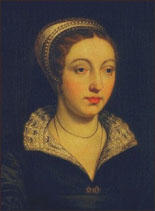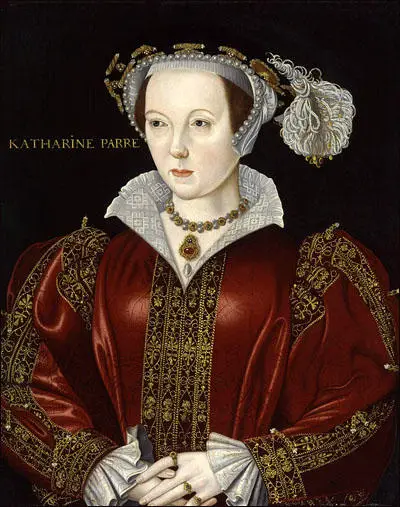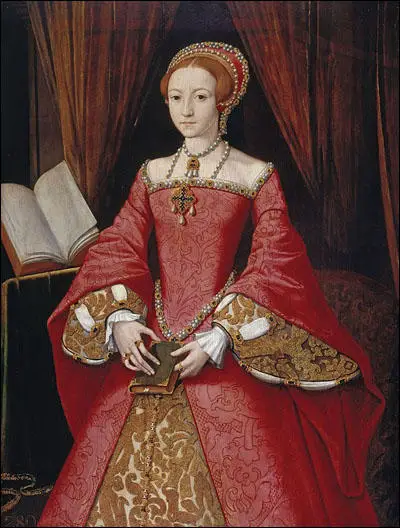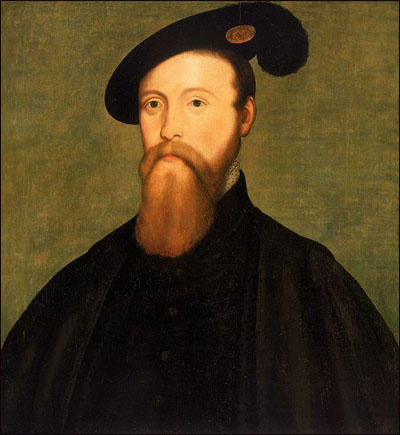Katherine Ashley

Katherine Champernowne, the daughter of Sir Philip Champernowne, a landowner from Modbury, Devon, was born in about 1502.
According to her biographer, Charlotte Merton: "She was related by marriage to all the leading gentry families of the west country. Nothing is known of her early life, although her distinctive, if old-fashioned, hand, her lifelong association with the reformed religion, and her key role in the education of Princess Elizabeth indicate that she received a better education than most women of her class and generation." (1)
Katherine joined the household of Princess Elizabeth in October 1536. It is believed that this was arranged by her brother-in-law Sir Anthony Denny. About 1545 she married John Ashley. The couple had no children and so she continued to work for Elizabeth as a governess. Elizabeth had never lived with her father, Henry VIII, and the loss of her mother, Anne Boleyn, at an early age, meant they were essentially both unknown to her. In Katherine (she always called her Kat) she had the "most loyal, if limited, of mother figures who had been with her all her life, and was to remain, until her death, the woman Elizabeth cared for most." (2)
After the death of her father on 28th January, 1547, Elizabeth and Katherine went to live with his widow, Catherine Parr. Henry's only son, Edward VI was only nine years old and was too young to rule. In his will, Henry had nominated a Council of Regency, made up of 16 nobles and churchman to assist Edward VI in governing his new realm. Edward Seymour, Duke of Somerset, emerged as the leading figure in the government and was given the title Lord Protector. His brother, Thomas Seymour, Lord Sudeley, proposed to the Council that he should marry the 13-year-old, Elizabeth, but he was told this was unacceptable.
Thomas Seymour
Seymour now set his sights on Catherine Parr. At the time he was described as "being gifted with charm and intelligence... and a handsome appearance". (3) Just a few weeks after Henry's death Catherine wrote to Seymour: "I would not have you think that this mine honest good will toward you to proceed from any sudden motion of passion; for, as truly as God is God, my mind was fully bent, the other time I was at liberty, to marry you before any man I know. Howbeit, God withstood my will therein most vehemently for a time, and... made that possible which seemed to me most impossible." (4)
The historian, Elizabeth Jenkins, believes that the "Queen Dowager, released from the sufferings of her marriage to Henry VIII, behaved like an enamoured girl." (5) Seymour wanted to marry Parr but realised the Council would reject his proposal, as it would be pointed out that if she became pregnant, there would have been uncertainty about whether the child was Seymour's or Henry's. (6) Seymour married Parr in secret in about May 1547.
Seymour visited Parr in her home in Chelsea before the news of their marriage was announced. This created extra problems as Elizabeth and Lady Jane Grey were also living with Parr at this time. (7) It has been pointed out that "Elizabeth was still only thirteen when her stepmother, of whom she was most fond, married for love. The young Princess remained in her care, living principally with her at her dower houses at Chelsea and Hanworth. Ever curious and watchful, Elizabeth could not fail to have noted the effects of the sudden transformation in Catherine Parr's life. From patient, pious consort of an ailing elderly king she had been transmuted into a lover, desired and desiring." (8)
Princess Elizabeth
Catherine Parr, who was now thirty-five, became pregnant. Although she had been married three times before, it was her first pregnancy. It came as a great shock as Catherine was assumed to be "barren". (9) Seymour now began paying more attention to Elizabeth. Katherine Ashley, Elizabeth's governess, later recorded: "Seymour... would come many mornings into the Lady Elizabeth's chamber, before she were ready, and sometimes before she did rise. And if she were up, he would bid her good morrow, and ask how she did, and strike her upon the back or on the buttocks familiarly, and so go forth through his lodgings; and sometime go through to the maidens and play with them, and so go forth... If Lady Elizabeth was in bed, he would... make as though he would come at her. And he would go further into the bed, so that he could not come at her." On one occasion Ashley saw Seymour try to kiss her while she was in bed and the governess told him to "go away for shame". Seymour became more bold and would come up every morning in his nightgown, "barelegged in his slippers". (10)

According to Elizabeth Jenkins, the author of Elizabeth the Great (1958) claims that the evidence suggested that the "Queen Dowager took to coming with her husband on his morning visits and one morning they both tickled the Princess as she lay in her bed. In the garden one day there was some startling horse-play, in which Seymour indulged in a practice often heard of in police courts; the Queen Dowager held Elizabeth so that she could not run away, while Seymour cut her black cloth gown into a hundred pieces. The cowering under bedclothes, the struggling and running away culminated in a scene of classical nightmare, that of helplessness in the power of a smiling ogre... The Queen Dowager, who was undergoing an uncomfortable pregnancy, could not bring herself to make her husband angry by protesting about his conduct, but she began to realize that he and Elizabeth were very often together." (11)
Jane Dunn has controversially argued that Elizabeth was a willing victim in these events: "Although not legally her step-father, Thomas Seymour assumed his role as head of the household and with his manly demeanour and exuberant animal spirits he became for the young Princess a charismatic figure of attraction and respect. Some twenty-five years her senior, Seymour in fact was old enough to be her father and the glamour of his varied heroic exploits in war and diplomatic dealings brought a welcome worldly masculinity into Elizabeth's cloistered female-dominated life.... Elizabeth was also attractive in her own right, tall with fair reddish-gold hair, fine pale skin and the incongruously dark eyes of her mother, alive with unmistakable intelligence and spirit. She was young, emotionally inexperienced and understandably hungry for recognition and love. She easily became a willing if uneasy partner in the verbal and then physical high jinks in the newly sexualised Parr-Seymour household." (12)

Sir Thomas Parry, the head of Elizabeth's household, later testified that Thomas Seymour loved Elizabeth and had done so for a long time and that Catherine Parr was jealous of the fact. In May 1548 Catherine "came suddenly upon them, where they were all alone, he having her (Elizabeth) in his arms, wherefore the Queen fell out, both with the Lord Admiral and with her Grace also... and as I remember, this was the cause why she was sent from the Queen." (13) Later that month Elizabeth was sent away to stay with Sir Anthony Denny and his wife, at Cheshunt. It has been suggested that this was done not as punishment but as a means of protecting the young girl. Philippa Jones, the author of Elizabeth: Virgin Queen (2010) has suggested that Elizabeth was pregnant with Seymour's child. (14)
Elizabeth wrote to Catherine soon after she left her home: "Although I could not be plentiful in giving thanks for the manifold kindness received at your highness' hand at my departure, yet I am something to be borne withal, for truly I was replete with sorrow to depart from your highness, especially leaving you undoubtful of health. And albeit I answered little, I weighed it more deeper when you said you would warn me of all evils that you should hear of me; for if your grace had not a good opinion of me, you would not have offered friendship to me that way that all men judge the contrary. But what may I more say than thank God for providing such friends to me, desiring God to enrich me with their long life, and me grace to be in heart no less thankful to receive it than I now am glad in writing to show it. And although I have plenty of matter, here I will stay for I know you are not quiet to read." (15)
Catherine Parr gave birth to a daughter named Mary on 30th August 1548. After the birth, Catherine developed puerperal fever. Her delirium took a painful form of paranoid ravings about her husband and others around her. Catherine accused the people around her of standing "laughing at my grief". She told the women attending her that her husband did not love her. Thomas Seymour held her hand and replied "sweetheart, I would do you no hurt". Seymour is reported to have lain down beside her, but Catherine asked him to leave because she wanted to have a proper talk with the physician who attended her delivery, but dared not for fear of displeasing him. (16)
The fever eventually went and she was able to dictate her will calmly, revealing that Seymour was the "great love of her life". Queen Catherine, "sick of body but of good mind", left everything to Seymour, only wishing her possessions "to be a thousand times more in value" than they were. Catherine, thirty-six years old, died on 5th September 1548, six days after the birth of her daughter. (17)
Katherine Ashley later claimed that Elizabeth took the news very badly. She refused to leave her bed and for the next five months she was unable to go more than a mile from the house. (18) Elizabeth wrote to Thomas Seymour thanking him for sending the physician, Dr. Thomas Bille, to attend to her. However, rumours began to circulate that the reasons that Elizabeth was housebound was because she was pregnant and that those around her were protecting her by alluding to her illness. (19)
Arrest of Thomas Seymour
Thomas Seymour sought to win Edward's affection and gain acceptance as his intimate adviser. He regularly visited Edward's bedchamber. Antonia Fraser has claimed: "He showed no greater greed than the rest of the nobility round him. Seymour's real weakness was his morbid jealously of his elder brother Somerset, whose military victories had first marked him out before his position as Protector raised him up." (20)
When his brother, Edward Seymour, Duke of Somerset, discovered what was happening he "put a special watch on all doors leading into the king's privy chamber in order to prevent Sudeley's clandestine entry". One night Thomas found the door to Edward's bedchamber bolted; enraged, he shot dead the king's barking dog. Somerset was given copies of letters that Sudeley had been passing to Edward. "Somerset found such correspondence intolerable" and ordered his brother's arrest in January, 1549. (21)

Elizabeth's governess, Katherine Ashley, and Sir Thomas Parry, the head of Elizabeth's household, were also arrested and interviewed by Sir Robert Tyrwhitt. They both provided accounts of Thomas Seymour's relationship with Elizabeth. On 22nd January, 1549, Tyrwhitt had a meeting with Elizabeth. He reported to Edward Seymour "all I have gotten yet is by gentle persuasion, whereby I do begin to grow with her in credit... this is a good beginning, I trust more will follow." (22)
On 28th January, Elizabeth wrote a letter to the Lord Protector denying that she was pregnant: "Master Tyrwhit and others have told me that there goeth rumours abroad which be greatly both against my honour and honesty, which, above all other things, I esteem, which be these, that I am in the Tower, and with child by my Lord Admiral (Thomas Seymour). My lord, these are shameful slanders, for the which, besides the great desire I have to see the king's majesty, I shall most heartily desire your lordship that I may show myself there as I am." (23)
The Lord Protector wrote back to her to say that if Elizabeth could identify anyone who uttered such slanders against her, the Council would have them punished. Elizabeth replied that she was unwilling to accuse specific people but suggested a better plan of action: "It might seem good to your lordship, and the rest of the council, to send forth a proclamation into the countries that they refrain their tongues, declaring how the tales be but lies, it should make both the people think that you and the council have great regard that no such rumours should be spread of any of the King's majesty's sisters (as I am, though unworthy) and also that I should think myself to receive such friendship at your hands as you have promised me, although your lordship showed me great already." (24)
Sir Robert Tyrwhitt attempted to discover if Katherine Ashley, Elizabeth and Sir Thomas Parry were involved in what was described a "marriage plot" with Thomas Seymour. However, they all refused to confess and Tyrwhitt reported, "They all sing the same song and so I think they would not do, unless they had set the note before." However, without confessions, Tyrwhitt was forced to release Ashley and Parry but Seymour was charged with 39 articles of treasonable activities, including that he "had attempted and gone about to marry the King's Majesty's sister, the Lady Elizabeth, second inheritor in remainder to the Crown." (25)
Thomas Seymour was examined on 18th and 23rd February but refused to answer unless his accusers stood before him. (26) Seymour demanded an open trial to face his accusers but this was denied. To prevent his brother, Edward Seymour, from showing leniency, the Council gained permission to act without the Lord Protector's authorization. On 20th March, 1549, Seymour was beheaded on Tower Hill. Even on the scaffold, Seymour refused to make the usual confession. Bishop Hugh Latimer commented: "Whether he be saved or no, I leave it to God, but surely he was a wicked man, and the realm is well rid of him." (27)
When she heard the news, it is claimed Elizabeth commented: "This day died a man of much wit and very little judgment." Elizabeth Jenkins, the author of Elizabeth the Great (1958) has pointed out: "If the words are apocryphal their tenor shows the effect of her beating. No one who saw her doubted the intensity of her emotion: they merely admired the fortitude with which she restrained it." (28)
Ashley was dismissed as Elizabeth's governess for her role in the Thomas Seymour affair. Elizabeth was furious at the loss of Katherine and she "wept and then sulked". Sir Robert Tyrwhitt reported to Edward Seymour that the young princess was in despair because she missed her so much. (29)
Robert Dudley
Katherine Ashley was reinstated by 1551, and remained in Elizabeth's service during the reign of Mary I. According to her biographer, Charlotte Merton: "Katherine enjoyed a level of favour after Elizabeth's accession matched by no women and few men. She was appointed chief gentlewoman of the privy chamber... Unsurprisingly, her relations with other leading figures were complex." (30)
Robert Dudley soon emerged as one of Elizabeth's leading advisers and was given the post of Master of the Horse. This made him the only man in England officially allowed to touch the Queen, as he was responsible for helping Elizabeth mount and dismount when she went horse-riding. (31) He was described as "splendid in appearance and a promptness and energy of devotion". (32) He was allotted official quarters in the palace. He encouraged her to go riding every day. Unlike most of her officials, Dudley was of her own age. "Although Elizabeth did have some women friends, she much preferred the company of men, and it soon became apparent that she preferred Robert Dudley's company to any other." (33)
According to Dudley's biographer, Simon Adams: "It was only in April 1559 that Robert Dudley's peculiar relationship to Elizabeth began to attract comment. This relationship - which defined the rest of his life - was characterized by her almost total emotional dependence on him and her insistence on his constant presence at court.... It also helps to explain his separation from his wife, who came to London from Throcking in May 1559, but spent only a month or so there." (34) In 1559 Elizabeth gave Dudley land in Yorkshire, as well as the manor of Kew. She also gave him a licence to export woolen cloth free of charge. (35) It is estimated that this was worth £6,000 in 1560.
David Starkey has pointed out that in many ways Dudley was similar to Thomas Seymour. "Dudley was strikingly similar to Seymour - in looks, physique and temperament. But whereas Seymour's seduction had involved the threat and perhaps the reality of force, Dudley was all soft words and whirlwind charm. It was the more attractive for that. Did Elizabeth surrender and have sexual relations? She denied it absolutely - just as she had denied it with Seymour. On the other hand, powerful rumour accused her." (36)
The Spanish ambassador, Gómez Suárez de Figueroa y Córdoba, 1st Duke of Feria, was one of those who spread these rumours. He wrote to King Philip II: "During the last few days Lord Robert has come so much into favour that he does what he likes with affairs and it is even said that her Majesty visits him in his chamber day and night. People talk of this so freely that they go so far as to say that his wife has a malady in one of her breasts and that the Queen is only waiting for her to die so she can marry Lord Robert." (37)
Another letter at the time from Paolo Tiepolo, the Venetian Ambassador, suggested that she had "been ailing for some time". It has been suggested that Amy was suffering from cancer and according to her maid, Mrs Pirto, her illness resulted in severe depression. However, on 24th August, 1560, she sent a letter to her tailor in a tone that was considered to be "cheerful" and shows her "looking forward to the pleasure of a new gown". (38)
Katherine Ashley warned Queen Elizabeth about the rumours and commented that she was behaving in such a way that would sully her "honour and dignity" and would in time undermine her subjects' loyalty. (39) When she suggested that Elizabeth should end her relationship with Dudley, the Queen angrrily retorted that if she showed herself gracious towards her Master of the Horse she had deserved it for his honourable nature and dealings: "She was always surrounded by her ladies of the bedchamber and maids of honour, who at all times could see whether there was anything dishonourable between her and her Master of the Horse." (40)
Katherine actively promoted rivals for Elizabeth's hand in marriage. This angered Sir Robert Dudley, and led to two more brief periods of imprisonment. Ashley remained in Elizabeth's service for the rest of her life. (41)
Katherine Ashley died in London on 18th July 1565.
Primary Sources
(1) Philippa Jones, Elizabeth: Virgin Queen (2010) page 118
Kat Ashley, who had endured several periods of imprisonment through her loyalty to Elizabeth, was made Mistress of the Maids of Honour, Chief Gentlewoman of the Privy Chamber and Keeper of the Close Stools. She would remain in Elizabeth's service until her death. The second Gentlewoman and Keeper of Her Majesty's Books was Blanche Parry, who had seen the infant Elizabeth rocked in her cradle. Both of these ladies had considerable sway when it came to influencing the Queen in smaller matters.
Student Activities
Henry VIII (Answer Commentary)
Henry VII: A Wise or Wicked Ruler? (Answer Commentary)
Henry VIII: Catherine of Aragon or Anne Boleyn?
Was Henry VIII's son, Henry FitzRoy, murdered?
Hans Holbein and Henry VIII (Answer Commentary)
The Marriage of Prince Arthur and Catherine of Aragon (Answer Commentary)
Henry VIII and Anne of Cleves (Answer Commentary)
Was Queen Catherine Howard guilty of treason? (Answer Commentary)
Anne Boleyn - Religious Reformer (Answer Commentary)
Did Anne Boleyn have six fingers on her right hand? A Study in Catholic Propaganda (Answer Commentary)
Why were women hostile to Henry VIII's marriage to Anne Boleyn? (Answer Commentary)
Catherine Parr and Women's Rights (Answer Commentary)
Women, Politics and Henry VIII (Answer Commentary)
Cardinal Thomas Wolsey (Answer Commentary)
Historians and Novelists on Thomas Cromwell (Answer Commentary)
Martin Luther and Thomas Müntzer (Answer Commentary)
Martin Luther and Hitler's Anti-Semitism (Answer Commentary)
Martin Luther and the Reformation (Answer Commentary)
Mary Tudor and Heretics (Answer Commentary)
Joan Bocher - Anabaptist (Answer Commentary)
Anne Askew – Burnt at the Stake (Answer Commentary)
Elizabeth Barton and Henry VIII (Answer Commentary)
Execution of Margaret Cheyney (Answer Commentary)
Robert Aske (Answer Commentary)
Dissolution of the Monasteries (Answer Commentary)
Pilgrimage of Grace (Answer Commentary)
Poverty in Tudor England (Answer Commentary)
Why did Queen Elizabeth not get married? (Answer Commentary)
Francis Walsingham - Codes & Codebreaking (Answer Commentary)
Codes and Codebreaking (Answer Commentary)
Sir Thomas More: Saint or Sinner? (Answer Commentary)
Hans Holbein's Art and Religious Propaganda (Answer Commentary)
1517 May Day Riots: How do historians know what happened? (Answer Commentary)
